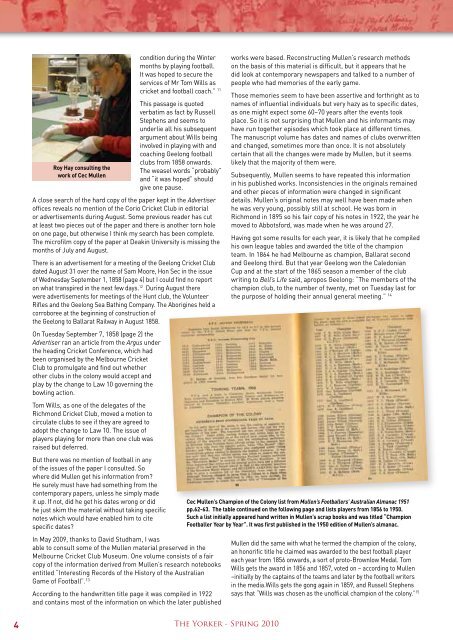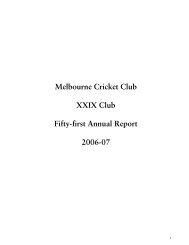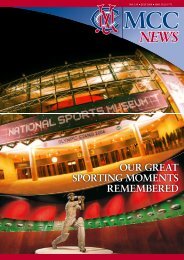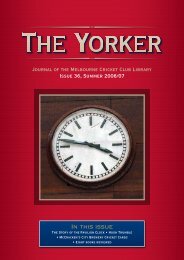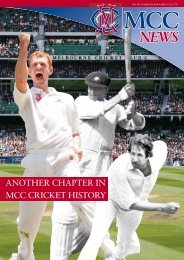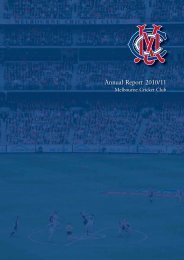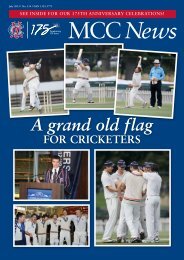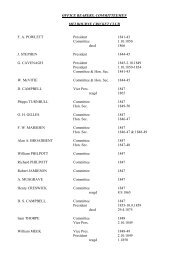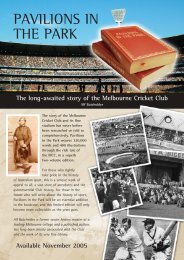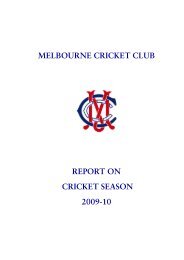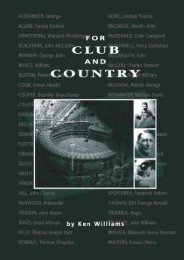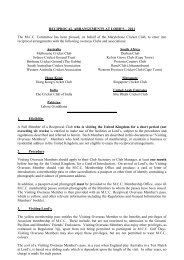Issue 42: Spring 2010 - Melbourne Cricket Club
Issue 42: Spring 2010 - Melbourne Cricket Club
Issue 42: Spring 2010 - Melbourne Cricket Club
Create successful ePaper yourself
Turn your PDF publications into a flip-book with our unique Google optimized e-Paper software.
Roy Hay consulting the<br />
work of Cec Mullen<br />
condition during the Winter<br />
months by playing football.<br />
It was hoped to secure the<br />
services of Mr Tom Wills as<br />
cricket and football coach.” 11<br />
This passage is quoted<br />
verbatim as fact by Russell<br />
Stephens and seems to<br />
underlie all his subsequent<br />
argument about Wills being<br />
involved in playing with and<br />
coaching Geelong football<br />
clubs from 1858 onwards.<br />
The weasel words “probably”<br />
and “it was hoped” should<br />
give one pause.<br />
A close search of the hard copy of the paper kept in the Advertiser<br />
offices reveals no mention of the Corio <strong>Cricket</strong> <strong>Club</strong> in editorial<br />
or advertisements during August. Some previous reader has cut<br />
at least two pieces out of the paper and there is another torn hole<br />
on one page, but otherwise I think my search has been complete.<br />
The microfilm copy of the paper at Deakin University is missing the<br />
months of July and August.<br />
There is an advertisement for a meeting of the Geelong <strong>Cricket</strong> <strong>Club</strong><br />
dated August 31 over the name of Sam Moore, Hon Sec in the issue<br />
of Wednesday September 1, 1858 (page 4) but I could find no report<br />
on what transpired in the next few days. 12 During August there<br />
were advertisements for meetings of the Hunt club, the Volunteer<br />
Rifles and the Geelong Sea Bathing Company. The Aborigines held a<br />
corroboree at the beginning of construction of<br />
the Geelong to Ballarat Railway in August 1858.<br />
On Tuesday September 7, 1858 (page 2) the<br />
Advertiser ran an article from the Argus under<br />
the heading <strong>Cricket</strong> Conference, which had<br />
been organised by the <strong>Melbourne</strong> <strong>Cricket</strong><br />
<strong>Club</strong> to promulgate and find out whether<br />
other clubs in the colony would accept and<br />
play by the change to Law 10 governing the<br />
bowling action.<br />
Tom Wills, as one of the delegates of the<br />
Richmond <strong>Cricket</strong> <strong>Club</strong>, moved a motion to<br />
circulate clubs to see if they are agreed to<br />
adopt the change to Law 10. The issue of<br />
players playing for more than one club was<br />
raised but deferred.<br />
But there was no mention of football in any<br />
of the issues of the paper I consulted. So<br />
where did Mullen get his information from?<br />
He surely must have had something from the<br />
contemporary papers, unless he simply made<br />
it up. If not, did he get his dates wrong or did<br />
he just skim the material without taking specific<br />
notes which would have enabled him to cite<br />
specific dates?<br />
In May 2009, thanks to David Studham, I was<br />
able to consult some of the Mullen material preserved in the<br />
<strong>Melbourne</strong> <strong>Cricket</strong> <strong>Club</strong> Museum. One volume consists of a fair<br />
copy of the information derived from Mullen’s research notebooks<br />
entitled “Interesting Records of the History of the Australian<br />
Game of Football”. 13<br />
According to the handwritten title page it was compiled in 1922<br />
and contains most of the information on which the later published<br />
works were based. Reconstructing Mullen’s research methods<br />
on the basis of this material is difficult, but it appears that he<br />
did look at contemporary newspapers and talked to a number of<br />
people who had memories of the early game.<br />
Those memories seem to have been assertive and forthright as to<br />
names of influential individuals but very hazy as to specific dates,<br />
as one might expect some 60–70 years after the events took<br />
place. So it is not surprising that Mullen and his informants may<br />
have run together episodes which took place at different times.<br />
The manuscript volume has dates and names of clubs overwritten<br />
and changed, sometimes more than once. It is not absolutely<br />
certain that all the changes were made by Mullen, but it seems<br />
likely that the majority of them were.<br />
Subsequently, Mullen seems to have repeated this information<br />
in his published works. Inconsistencies in the originals remained<br />
and other pieces of information were changed in significant<br />
details. Mullen’s original notes may well have been made when<br />
he was very young, possibly still at school. He was born in<br />
Richmond in 1895 so his fair copy of his notes in 1922, the year he<br />
moved to Abbotsford, was made when he was around 27.<br />
Having got some results for each year, it is likely that he compiled<br />
his own league tables and awarded the title of the champion<br />
team. In 1864 he had <strong>Melbourne</strong> as champion, Ballarat second<br />
and Geelong third. But that year Geelong won the Caledonian<br />
Cup and at the start of the 1865 season a member of the club<br />
writing to Bell’s Life said, apropos Geelong: “The members of the<br />
champion club, to the number of twenty, met on Tuesday last for<br />
the purpose of holding their annual general meeting.” 14<br />
Cec Mullen’s Champion of the Colony list from Mullen’s Footballers’ Australian Almanac 1951<br />
pp.62-63. The table continued on the following page and lists players from 1856 to 1950.<br />
Such a list initially appeared hand written in Mullen’s scrap books and was titled “Champion<br />
Footballer Year by Year”. It was first published in the 1950 edition of Mullen’s almanac.<br />
Mullen did the same with what he termed the champion of the colony,<br />
an honorific title he claimed was awarded to the best football player<br />
each year from 1856 onwards, a sort of proto-Brownlow Medal. Tom<br />
Wills gets the award in 1856 and 1857, voted on – according to Mullen<br />
–initially by the captains of the teams and later by the football writers<br />
in the media.Wills gets the gong again in 1859, and Russell Stephens<br />
says that “Wills was chosen as the unofficial champion of the colony.” 15<br />
4 The Yorker - <strong>Spring</strong> <strong>2010</strong>


